Asian Mason Jar Soup (Just Add Water)
This Asian Mason Jar Soup is a meal prep dream, requiring minimal effort and zero cooking. Simply layer the fresh ingredients in a jar, add the broth base, seal the lid, and you’ve got yourself a delicious, ready-to-eat meal. When you are ready for lunch or dinner, just add water. It’s the perfect solution for those seeking convenience without sacrificing flavor.
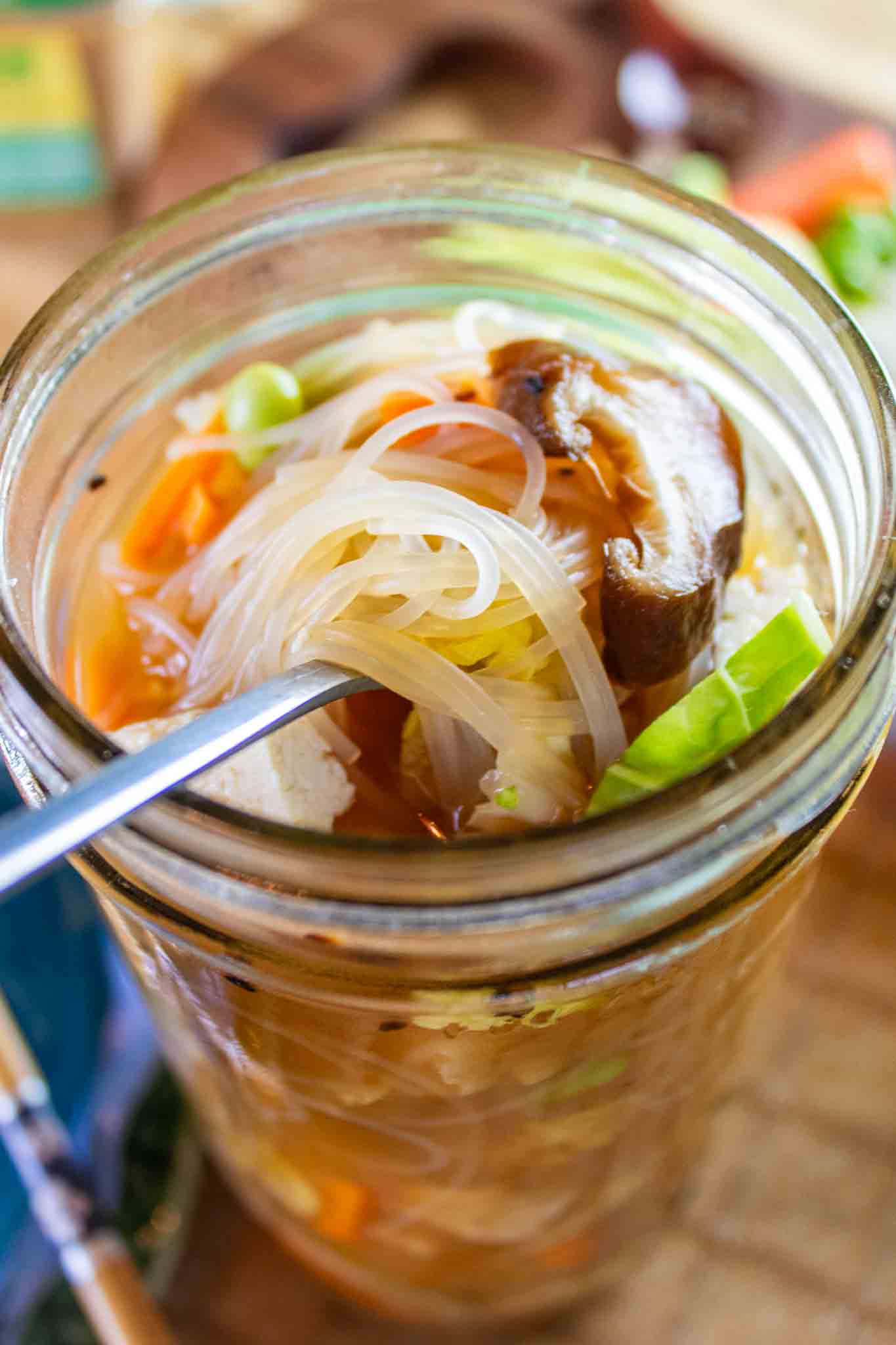
The first time I ever heard of mason jar soup was on Carleigh Bodrug’s PlantYou Instagram page, and she made it look so easy and delicious. I knew we had to give it a try! It was absolutely amazing, so we came up with our own Asian version to share with our followers.
This healthy homemade Asian noodle jar soup recipe has a warm savory miso base that is absolutely delightful and requires minimal effort to prepare. When you are ready to eat it, just add water! It is gluten-free, vegetarian, and vegan; everyone is going to love it!
If you love soups in a jar, take a look at our new Mexican Mason Jar Soup as well. We love super easy soup recipes like 15-minute bean chili and this somen cold noodle soup.
Mason jar soups
Meal prepping is a breeze with these DYI mason jar noodle soups because they are super easy to put together. You can prep a week’s worth of jars from start to finish in about 15 minutes!
Drop in Asian rice noodles, chop and add your personalized toppings, sprinkle your soup base ingredients on the top, seal the lid, and refrigerate until you’re ready to eat!
Need a meal to go? Mason jar soup recipes are commute-friendly (lightweight and no leaking) AND once you’re ready to eat, just add hot water and they’re ready in 4-5 minutes!
Reasons you will love this soup
- Quick and Convenient: This easy Asian mason jar soup is perfect for busy days—just add hot water, and you have a delicious vegan meal ready in minutes.
- Flavor-Packed and Nutritious: Loaded with fresh veggies, noodles, and savory spices, this vegan mason jar soup offers a burst of authentic Asian flavors while being packed with nutrients.
- Customizable and Versatile: You can easily customize this mason jar soup by adding your favorite vegetables, tofu, or spices, making it a versatile option for any meal.
- Perfect for Meal Prep: Great for meal prepping, this mason jar soup can be prepared ahead of time and stored in the fridge, so you always have a healthy, plant-based meal ready to go.
Ingredients you will need
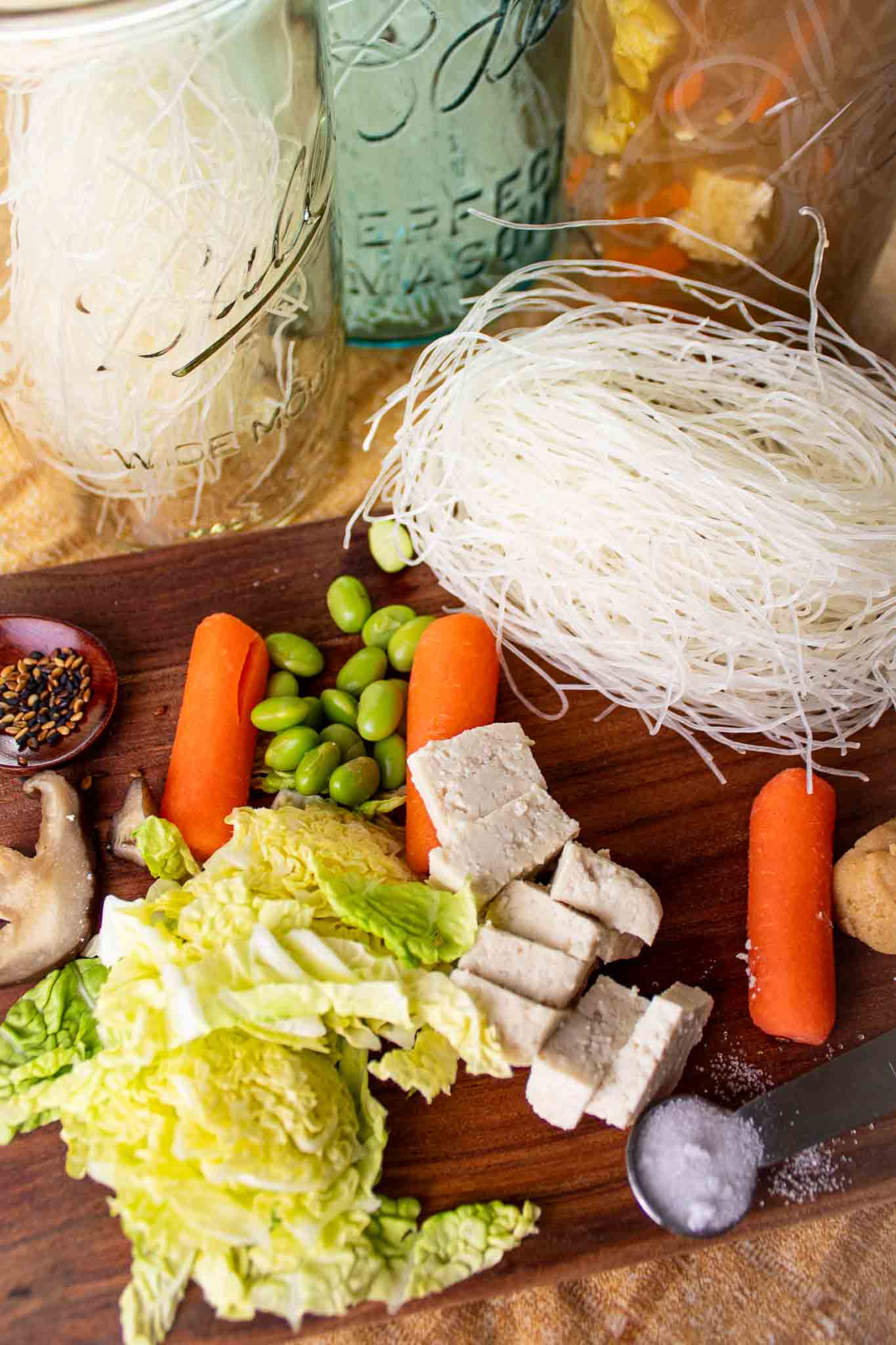
- Miso- This can be found in the refrigerated section of many grocery stores as well as natural food stores and Asian markets. It is commonly called soybean paste and has a mellow, slightly sweet flavor.
- Soy Sauce- If you need your soup to be gluten-free, substitute tamari.
- Sweetener- Pure cane sugar is my preference, but other options could include date sugar/syrup, maple sugar/syrup, or others.
- Tofu- Made from soybeans, tofu is sold in block form in a variety of textures that range from silken to extra firm, and they differ mainly in the amount of water retained. Tofu can be found in the refrigerated section of many grocery stores as well as natural food stores and Asian markets. The shelf-stable variety is sometimes a little more difficult to find in stores, but it doesn’t need to be refrigerated. I order mine online and have it shipped right to my door.
- Noodles– I like to use glass noodles, also called harusame, cellophane, or bean thread noodles. They are thin, transparent, gluten-free noodles made of potato or sweet potato starch. Rice vermicelli noodles are made from rice flour and water and are also a great option. You can use these types of quick-cooking noodles in spring rolls, noodle salads, stir-fries, vegetable soups, and hot pot dishes. They are clear, silky-smooth, and have a delightful chewy texture. Their neutral flavor soaks up broths, soups, and seasonings well.
- Vegetables- The veggies chosen to use are based on your preference. Some of my favorites are napa cabbage, broccoli, and carrots. I have included a full list of more ideas in the next section.
- Sesame seeds- You don’t have to use white and black sesame seeds, but they do offer two different flavors so if you have them on hand, it adds to the complexity of the flavor.
Tips & Suggestions
- Layering: I like to add the glass noodles to the jar first so I can be sure they’re completely immersed in the water.
- Noodles: Feel free to mix it up and use any variety of fast cooking or precooked noodles. Be sure the noodle you choose doesn’t need to be rinsed.
- Veggies: Frozen veggies work very well in this soup-in-a-jar recipe.
- Temperature: Do not put boiling water into a jar straight out of the fridge. Let the jar warm to room temperature before adding the boiling water. Rapid temperature changes can result in broken glass.
- Safety: I recommend not shaking the jar once you add the water, stirring is sufficient. Pressure builds in a jar with boiling water and shaking can amplify that process. Use oven mitts or a kitchen towel to handle a hot jar until it cools.
How to make soup in a Mason jar
The recipe card at the bottom of the page has the full list of ingredients with measurements and instructions.
STEP #1: I like to begin by adding the glass noodles or vermicelli rice noodles to the jar first so that they’re on the bottom, and I can be sure they’re completely immersed in the water. See the best type of jar to use in the section below.
STEP #2: Gather your choice of add-in ingredients. Choose ingredients for each jar depending on how long it will be before you use them. For instance, I would only add tofu and bean sprouts to a jar I plan to eat within 3 days. Slice add-ins into bite-size pieces and drop them into the canning jar.
STEP #3: Add your three soup-broth ingredients–soy sauce, miso paste, and sweetener–to the top of the jar, put on the lid, and refrigerate.
STEP #4: When you are ready to eat, remove the lid, boil 2 cups of water, and pour over the ingredients in the jar. Make sure the jar has reached room temperature before carefully adding the boiling water. Alternatively, add 2 cups of cold water to your jar and heat in a microwave for 2-3 minutes on high power.
STEP #5: Place the lid on the jar but do not shake the jar; pressure builds up from the hot water. Allow it to sit covered for 4-5 minutes, stir, and EAT!
Add-in options
- Toasted sesame seeds (white, black, or both)
- Napa Cabbage or Boy Chok
- Carrots
- Broccoli
- Mushrooms (Shitake, enoki, button, etc)
- Tofu
- Bean Sprouts
- Edamame, frozen, or snap peas
- Water chestnuts
- Bamboo slices
- Kimchi (for a little extra spice)
The best jar size to use
Use a 24oz or 32 oz canning jar with a wide mouth. A wide mouth makes it easier to add ingredients and to eat from.
Any quart-size wide-mouth canning jar and sealable lid will work (Ex: Ball, Mason, Anchor, etc.) Your jar needs to be able to withstand boiling water temperatures without cracking. Most smooth-sided jars are not designed to be used at high temperatures.
Frequently Asked Questions
Yes, but it’s best to use wide-mouth mason jars that are heat-resistant, such as those made from tempered glass, which can safely handle hot water. Make sure the jars have tight-fitting lids to prevent spills and maintain freshness. See my notes above.
Great ingredients for mason jar soup include pre-cooked noodles, fresh or frozen vegetables, tofu or beans for protein, and seasonings like garlic, ginger, and soy sauce. You can also add miso paste or bouillon for extra flavor, and top with fresh herbs before serving.
This soup base can be stored in the fridge for up to 5 days. It’s fine to food prep and add all ingredients ahead of time as long as they won’t spoil before you consume them. For instance, I would use my bean sprouts and tofu ingredients at the beginning of the week.
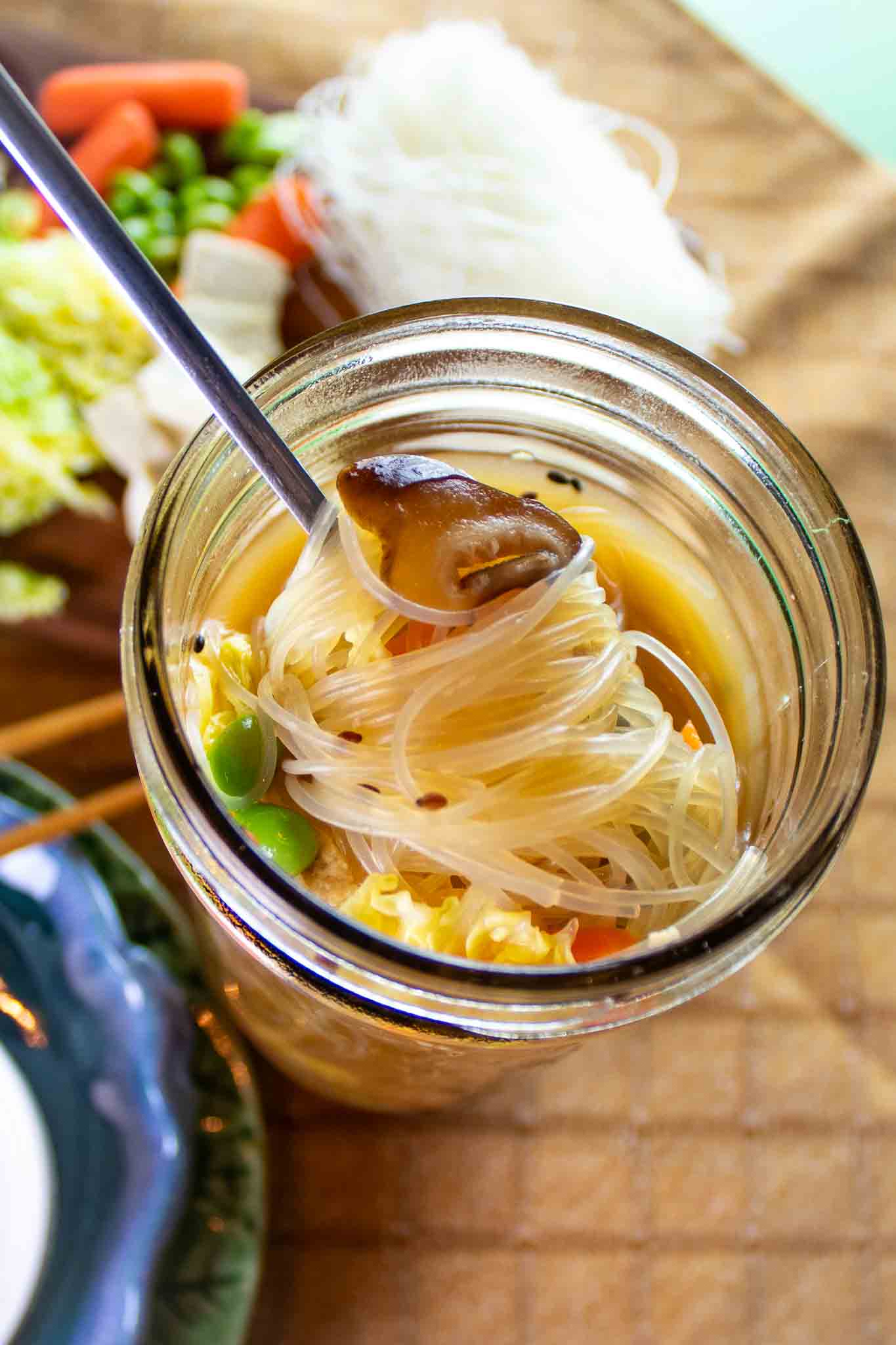
For those of you new to the whole food plant-based lifestyle, we’ve created a FREE 7-Day Plant-Based Menu Planner to help you get started!
If you try this recipe, please let us know how you like it by rating it and leaving a comment. We love to hear from you!
Want to Save This Recipe?
Enter your email & I’ll send it to your inbox. Plus, get great new recipes from me every week!
By submitting this form, you consent to receive emails from EatPlant-Based

Asian Mason Jar Soup
Ingredients
Soup Broth
- 1 tablespoon low sodium soy sauce or tamari for gluten-free
- 2 teaspoons miso paste white or red
- 1/2 teaspoon sweetener pure cane sugar, date sugar, maple sugar
Main Ingredients
- 1 bundle vermicelli rice noodles or glass noodles, 1" diameter, about size of a quarter
- 1/2 cup tofu in cubes
- 1/4 cup shredded cabbage
- 1/4 cup carrots shredded or diced
- 1/4 cup broccoli florets
- 1/4 cup mushrooms sliced
- 1/4 cup bean sprouts
- 1/2 teaspoon toasted sesame seeds
- 2 cups boiling water (when ready to eat)
Instructions
- I like to begin by adding the glass noodles or vermicelli rice noodles to the jar first so that they’re on the bottom, and I can be sure they’re completely immersed in the water. See the best type of jar to use in the NOTES section below.
- Gather your choice of add-in ingredients. Choose ingredients for each jar depending on how long it will be before you use them. For instance, I would only add tofu and bean sprouts to a jar I plan to eat within 3 days. Slice add-ins into bite-size pieces and drop them into the canning jar. I have included a whole list of add-in options in the article above.
- Add your three soup-broth ingredients–soy sauce, miso paste, and sweetener–to the top of the jar, put on the lid, and refrigerate.
- When you are ready to eat, remove the lid, boil 2 cups of water, and pour over the ingredients in the jar. Make sure the jar has reached room temperature before carefully adding the boiling water. Alternatively, add 2 cups of cold water to your jar and heat in a microwave for 2-3 minutes on high power.
- Place the lid on the jar but do not shake the jar; pressure builds up from the hot water. Allow it to sit covered for 4-5 minutes, stir, and EAT!
Video
Notes
Nutrition
Disclaimer
To obtain the most accurate representation of the nutritional information in a given recipe, you should calculate the nutritional information with the actual ingredients used in your recipe, using your preferred nutrition calculator. You are solely responsible for ensuring that any nutritional information provided is accurate, complete, and useful.
About the Chef
Drenda-Michell Brennan lived in Japan in the 1980s and 90s where she enjoyed spending much of her time visiting the kitchens of family and friends, watching and learning to prepare traditional Japanese cuisine. She is the mother of three Japanese-American grown children and grandmother (HuneyGram) to nine grandchildren. Read More…


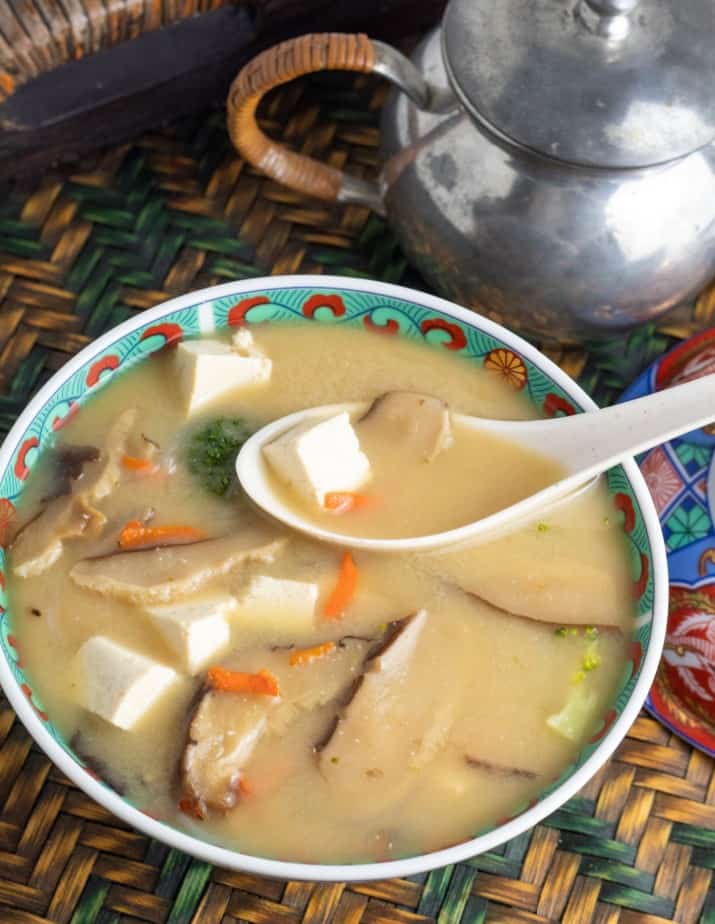
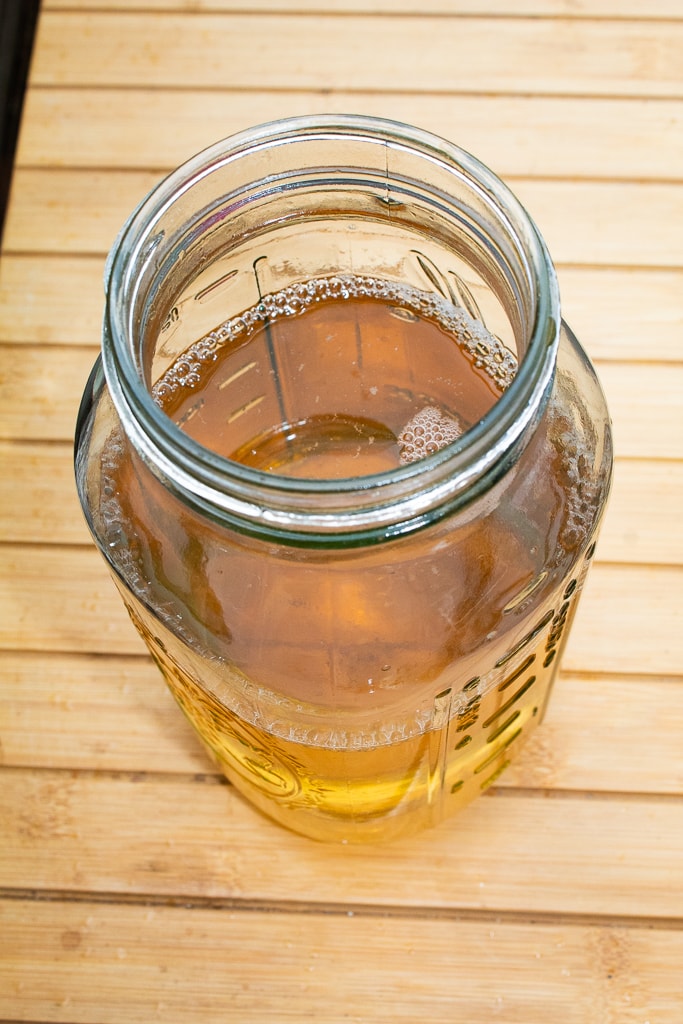
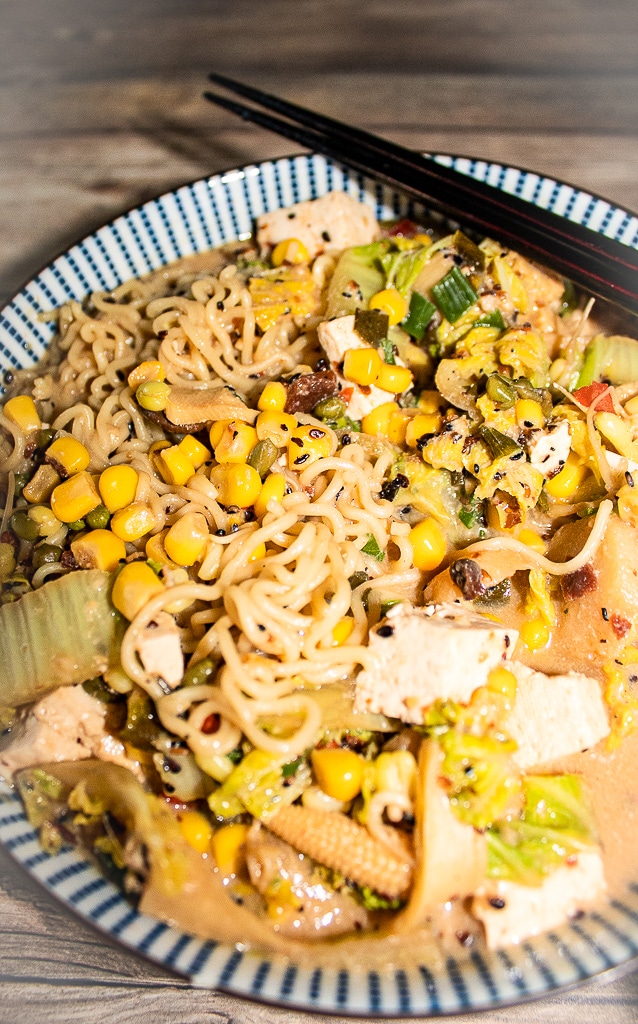

Should the noodles be cooked before you put them in the jar?
No need to cook the noodles before hand. It makes it super simple.
Great idea! Thanks
Love the quick and easy option this provides. Great on a chilly day. Enjoying a jar as I type.